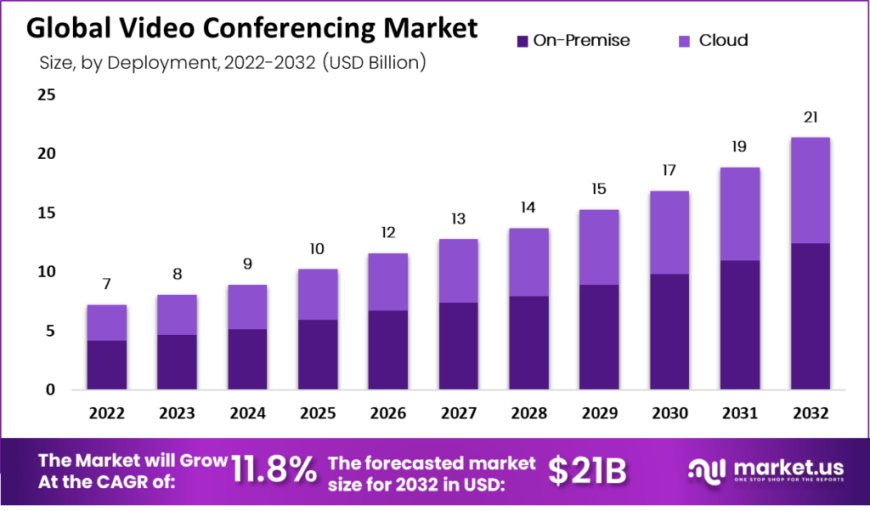Video Conferencing Market: Revolutionizing Business Communication
The Global Video Conferencing Market size is expected to be worth around USD 21 billion by 2032 from USD 8.0 billion in 2023, growing at a CAGR of 11.8% during the forecast period 2023 to 2032.
Introduction
The video conferencing market has seen tremendous growth in recent years, driven by the increasing need for remote communication and collaboration. Key growth factors include the widespread adoption of remote work, advancements in communication technologies, and the globalization of businesses requiring cross-border collaboration.
Read More - https://market.us/report/video-conferencing-systems-market/
However, the market also faces challenges such as data security concerns, technical glitches, and the need for high-speed internet connectivity. Despite these challenges, there are numerous opportunities for new entrants, especially in developing innovative features, offering cost-effective solutions, and targeting niche markets.
Emerging Trends
- AI-Powered Features: Artificial intelligence is enhancing video conferencing with features like real-time language translation, automated note-taking, and smart background management.
- Hybrid Meeting Solutions: The blend of in-person and virtual meeting options is becoming standard, catering to both office-goers and remote workers.
- Enhanced Security Measures: With growing concerns over data privacy, there is a trend towards more secure, encrypted communication channels.
- Integration with Business Tools: Video conferencing platforms are increasingly integrating with other business tools like CRM and project management software for seamless workflows.
- Immersive Experiences: The use of augmented reality (AR) and virtual reality (VR) is emerging, providing more engaging and interactive meeting experiences.
Top Use Cases
- Remote Work and Telecommuting: Video conferencing is essential for maintaining communication and collaboration among remote teams.
- Virtual Events and Webinars: Businesses and organizations use video conferencing for hosting webinars, training sessions, and virtual events.
- Telemedicine: Healthcare providers leverage video conferencing to consult with patients remotely, providing convenient and timely care.
- Online Education and E-Learning: Educational institutions use video conferencing to conduct online classes, making education more accessible.
- Customer Support and Services: Companies use video conferencing to offer personalized customer support, enhancing customer experience.
Major Challenges
- Data Privacy and Security: Ensuring the confidentiality and security of conversations and data is a significant concern.
- Technical Issues: Connectivity problems, software glitches, and compatibility issues can disrupt meetings.
- User Fatigue: Prolonged use of video conferencing can lead to "Zoom fatigue," affecting productivity and well-being.
- High Initial Costs: Setting up high-quality video conferencing systems can be expensive for small businesses.
- Bandwidth Dependency: Effective video conferencing requires reliable and high-speed internet, which can be a limitation in certain regions.
Market Opportunity
- Innovative Solutions: Developing unique features like AI enhancements or VR integration can differentiate products in the market.
- Affordable Solutions for SMEs: Creating cost-effective options for small and medium-sized enterprises (SMEs) can tap into a large market segment.
- Localized Offerings: Providing solutions tailored to specific regions or languages can cater to diverse global needs.
- Cross-Platform Compatibility: Ensuring seamless integration with various devices and operating systems can increase accessibility.
- Focus on Security: Prioritizing data security and compliance with regulations can attract privacy-conscious users.
Conclusion
The video conferencing market is rapidly evolving, with significant growth driven by technological advancements and the increasing need for remote communication. While challenges like data security and user fatigue present hurdles, they also offer opportunities for innovation and improvement.
New entrants can succeed by focusing on affordability, security, and the integration of cutting-edge technologies. As the world continues to embrace digital transformation, the demand for efficient and reliable video conferencing solutions will only grow, making it a promising market for the future.

